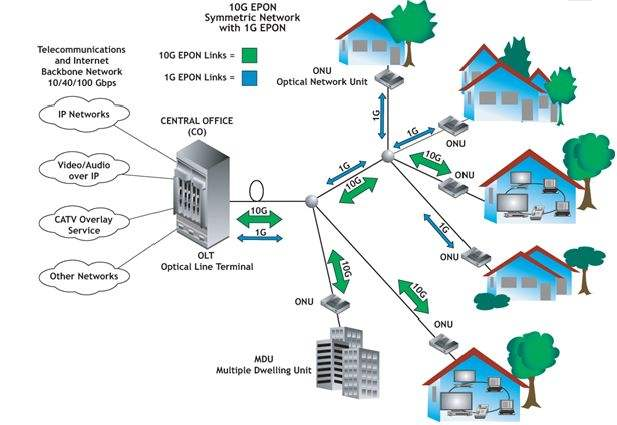
With the progress and development of human society, water, electricity, and gas have become essential infrastructure for people's lives. It is hard to imagine how a house without supporting facilities such as water and electricity can be sold. At present, we are entering the digital age from the industrial age. The prosperity and development of digital applications are changing people's lifestyles, but broadband infrastructure, as a carrier of digital life, has not kept up and has not become a standard infrastructure for housing. The reason is that laying optical fiber requires re-construction, which brings additional difficulties to both operators and users, increases a lot of money and time consumption, and ultimately seriously affects the digitalization process.
Challenges of FTTH Construction by Operators
FTTH has become the mainstream model for operators to build new broadband networks. However, operators are also generally facing the situation that traditional businesses are squeezed by OTT and operating profits are declining. The large investment and long payback period of FTTH network construction are one of the common problems facing operators. According to industry statistics, the cost of FTTH last mile to the home accounts for 10% to 20% of the cost per household. The second problem is that the laying of optical fiber last mile often faces obstruction from property management and non-cooperation from users, such as property management deliberately delaying approval time, asking for exorbitant prices or making unreasonable demands for their own selfish interests, or even deliberately destroying broadband facilities; users are also unwilling to cooperate because wiring and drilling will damage the decoration. The third problem comes from the technical aspect. There are thousands of buildings with very different scenarios, which makes the laying of optical fiber difficult and time-consuming. Some buildings are difficult to complete the laying and renovation of optical fiber due to historical reasons.
Two-pronged approach to solve the problem of fiber access to the home
Real estate developers have long been accustomed to providing pipes and cables for new houses to provide services such as electricity, telephone and cable TV. The most typical model is that developers cooperate with service providers. When building and renovating houses, developers provide pipelines to connect houses/buildings to existing public facilities outside the building red line. Generally, there are 2 telephone pipelines, 1 cable TV pipeline and 4 power pipelines. On top of this, the cost of adding 2 more fiber optic pipelines in the same trench is very small, and it can avoid the weeks of permit application, design, coordination and construction work brought about by re-laying pipelines.
At the same time, the government should formulate standards and require developers to provide fiber-to-the-home pipelines or direct fiber-to-the-home when building and renovating houses. Indoor fiber optic pipelines can also be constructed at the same time as the wiring and positioning of power, telephone and cable TV pipelines, greatly improving the speed of fiber optic deployment and reducing the cost of fiber optic deployment. Fiber-to-the-home pipelines should follow industry standards (TIA/ANSI), and their bending radius, length, gap and terminal location should match technical needs, and be equipped with appropriate telecommunications cabinets according to the number of households.
The policy of pre-buried fiber optic access to homes has gradually become an industry standard .
In recent years, more and more regions and countries have begun to implement fiber-to-the-home policies.
Many cities in the United States have also implemented the fiber-to-the-home requirement. For example, Loma Linda in California implemented this requirement early in its "Connected Community Project" (LLCCP). Its city council requires: "All new commercial and residential buildings in the city (or renovation of more than 50% of old buildings) must be equipped with new network infrastructure to meet people's communication needs." Its specific requirements also include: laying fiber optic pipelines during real estate development, building community optical distribution frames, configuring data cabinets in master bedrooms, connecting optical fibers to data cabinets and distribution frames, installing two Cat6 interfaces and one coaxial interface in each room, and the design and materials of the fiber optic network are uniformly managed by the city.
Some regions in Europe have also implemented the requirement of fiber-to-the-home. In May 2014, the European union passed the DIRECTIVE 2014/61/EU Directive, requiring the full implementation of the fiber-to-the-home policy in 2017: All building permit applications submitted after December 31, 2016, whether new or renovated, must be equipped with high-speed broadband network infrastructure, and the "Broadband-ready" label will be issued after completion and acceptance, and it is stipulated that its network must be open to broadband service providers in a fair and non-discriminatory manner.
In addition, there are South Korea, which has implemented it very early, Morocco, which is about to release the policy, and Indonesia, which is actively promoting it... Many countries around the world are actively promoting the fiber-to-the-home policy.
Although pre-buried fiber-to-the-home has put forward new requirements for developers, through the coordinated construction with other pipelines, its incremental burden on developers is very small, but it has a very significant role in promoting the construction of FTTH and regional digitalization, especially in areas where there are a large number of new and renovated houses. In order to improve the progress of FTTH deployment, accelerate digital transformation, and promote macroeconomic development, we believe that pre-buried optical fiber should become a new basic supporting facility for houses in the digital age, and should be promoted and implemented as a strategic requirement.